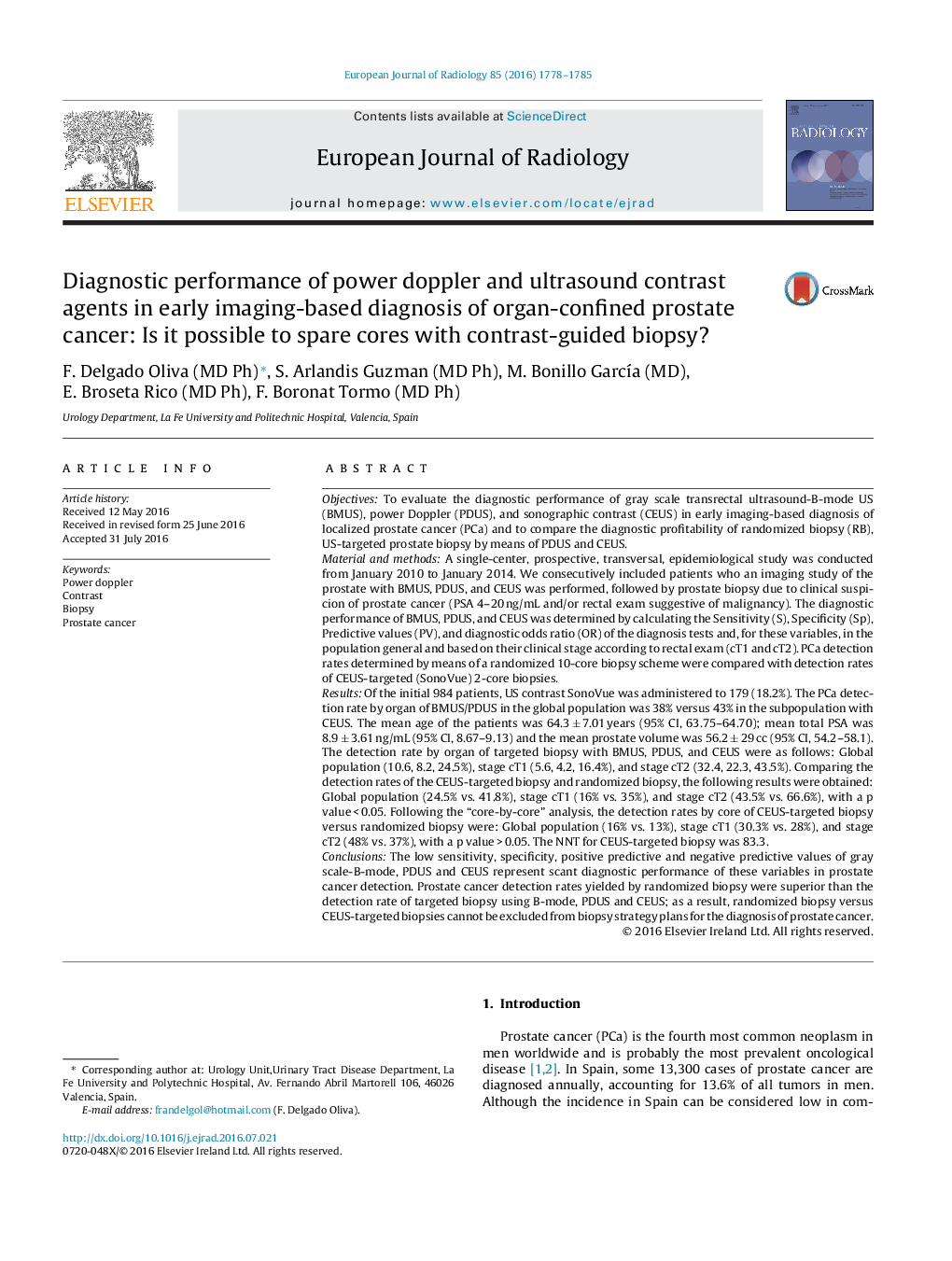| کد مقاله | کد نشریه | سال انتشار | مقاله انگلیسی | نسخه تمام متن |
|---|---|---|---|---|
| 4224900 | 1609737 | 2016 | 8 صفحه PDF | دانلود رایگان |
ObjectivesTo evaluate the diagnostic performance of gray scale transrectal ultrasound-B-mode US (BMUS), power Doppler (PDUS), and sonographic contrast (CEUS) in early imaging-based diagnosis of localized prostate cancer (PCa) and to compare the diagnostic profitability of randomized biopsy (RB), US-targeted prostate biopsy by means of PDUS and CEUS.Material and methodsA single-center, prospective, transversal, epidemiological study was conducted from January 2010 to January 2014. We consecutively included patients who an imaging study of the prostate with BMUS, PDUS, and CEUS was performed, followed by prostate biopsy due to clinical suspicion of prostate cancer (PSA 4–20 ng/mL and/or rectal exam suggestive of malignancy). The diagnostic performance of BMUS, PDUS, and CEUS was determined by calculating the Sensitivity (S), Specificity (Sp), Predictive values (PV), and diagnostic odds ratio (OR) of the diagnosis tests and, for these variables, in the population general and based on their clinical stage according to rectal exam (cT1 and cT2). PCa detection rates determined by means of a randomized 10-core biopsy scheme were compared with detection rates of CEUS-targeted (SonoVue) 2-core biopsies.ResultsOf the initial 984 patients, US contrast SonoVue was administered to 179 (18.2%). The PCa detection rate by organ of BMUS/PDUS in the global population was 38% versus 43% in the subpopulation with CEUS. The mean age of the patients was 64.3 ± 7.01 years (95% CI, 63.75–64.70); mean total PSA was 8.9 ± 3.61 ng/mL (95% CI, 8.67–9.13) and the mean prostate volume was 56.2 ± 29 cc (95% CI, 54.2–58.1). The detection rate by organ of targeted biopsy with BMUS, PDUS, and CEUS were as follows: Global population (10.6, 8.2, 24.5%), stage cT1 (5.6, 4.2, 16.4%), and stage cT2 (32.4, 22.3, 43.5%). Comparing the detection rates of the CEUS-targeted biopsy and randomized biopsy, the following results were obtained: Global population (24.5% vs. 41.8%), stage cT1 (16% vs. 35%), and stage cT2 (43.5% vs. 66.6%), with a p value < 0.05. Following the “core-by-core” analysis, the detection rates by core of CEUS-targeted biopsy versus randomized biopsy were: Global population (16% vs. 13%), stage cT1 (30.3% vs. 28%), and stage cT2 (48% vs. 37%), with a p value > 0.05. The NNT for CEUS-targeted biopsy was 83.3.ConclusionsThe low sensitivity, specificity, positive predictive and negative predictive values of gray scale-B-mode, PDUS and CEUS represent scant diagnostic performance of these variables in prostate cancer detection. Prostate cancer detection rates yielded by randomized biopsy were superior than the detection rate of targeted biopsy using B-mode, PDUS and CEUS; as a result, randomized biopsy versus CEUS-targeted biopsies cannot be excluded from biopsy strategy plans for the diagnosis of prostate cancer.
Journal: European Journal of Radiology - Volume 85, Issue 10, October 2016, Pages 1778–1785
